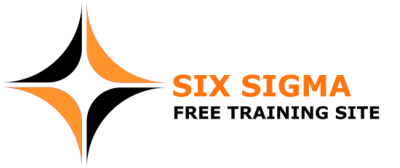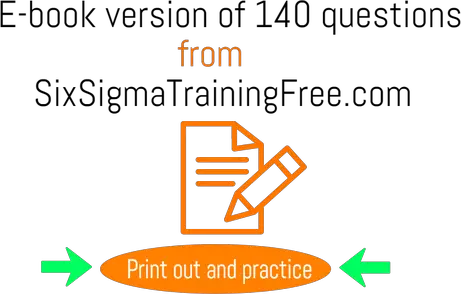ANALYZE Six Sigma Training Test
Six Sigma Certification Exam Questions with Answers based on ASQ Black Belt BOK DMAIC sections
ANALYZE
(Answers can be found below)
|
1) At a six sigma training session a black belt candidate was asked to interpret the correlation coefficient (r) of -0.9 between absenteeism and performance evaluation scores at an engineering department. Which is the correct interpretation that she needs to choose?
a) Absenteeism causes low performance scores b) There is no connection between performance scores and absenteeism c) There is a strong inverse association between two variables d) A confounding variable causes absenteeism drop as the performance scores increase 2) At a lean six sigma certification test, a LSS black belt candidate correctly answered that Type I error occurs when _________________________________________________________. a) The null hypothesis is rejected when it is true b) The null hypothesis is not rejected when it is false c) The alternative hypothesis is accepted when it is false d) The alternative hypothesis is rejected when it is false 3) At a Motorola factory, a process improvement team consisting of a black belt and three green belts identified 5 main defect types responsible for faulty cell phones and plotted them on a ________ _________. In a sample of 120 phones 50% of defects were due to defective antennas, 30% due to chip malfunctioning, 10% due to broken screens, 8% due to external cracks and the rest of the defect types accounted for the remaining 2%. In order to target “vital few”, the team decided to focus its efforts on antennas and chips which accounted for cumulative 80% of overall defects. a) Scatter diagram b) Defects plot c) Cumulative chart d) Pareto chart 4) A lean six sigma training provider -“Six Sigma Certification Online” - commissioned a multi-vary study to analyze caller waiting time in its 4 training centers. The study found that caller waiting times did not vary from center to center as well as within centers during operation hours (9 am to 5 pm). The largest variance was found between days of the week, with Mondays having the longest caller waiting time. Which is responsible for the greatest variance? a) Cyclical variation b) Multi-various cycle c) Positional variation d) Temporal variation |
|
5) During the analyze phase of a six sigma project master black belt needs to perform hypothesis testing by comparing the means of two samples which may or may not be drawn from a normally distributed data. He decides not to risk and substitute 2 sample t-test with a corresponding nonparametric test. Which test should he choose?
a) Lavene’s test
b) Mann-Whitney test
c) Z-test
d) Contingency tables
More practice tests:

